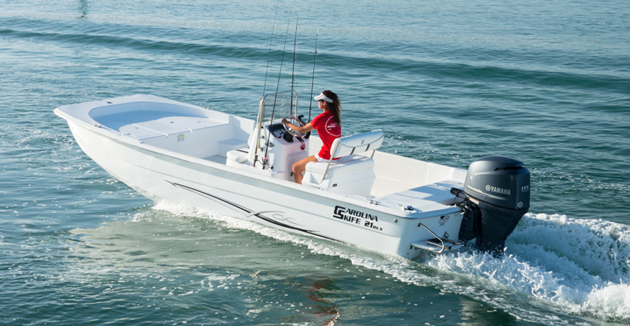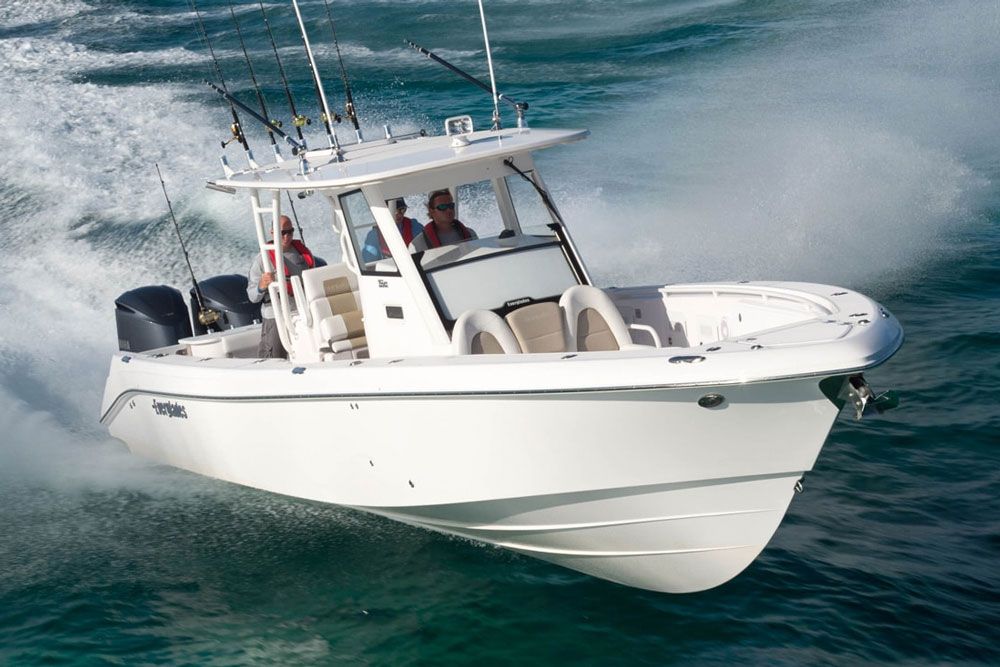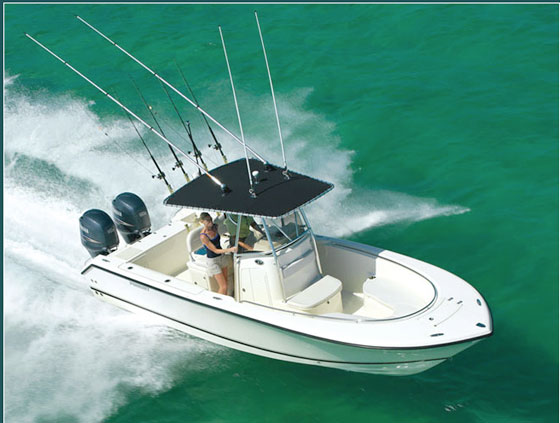Advertisement
Advertisement
Boat Hull Shapes: What Hull Shape is Best?
When it comes to boat hull types, their designs are crucial to your boating pleasure.
May 31, 2021
Whether your boat has a large engine or a small one, one bunk or a dozen cabins, a gourmet galley or a one-burner stove, there is nothing—absolutely nothing—that will make as much difference to your boating pleasure as the design of your hull.
Different Types of Boat Hulls:
- Flat Bottom Hulls: a hull that has almost no deadrise
- Deep-V Hulls: a wedge-shaped hull from bow to stern
- Modified-V Hulls: the most common hull for small boats
- Catamarans: two hulls bridged by a deck
- Chines and Strakes: molded strips run lengthwise along the hull bottom and are virtually universal on modern planing boats

How your boat's hull is shaped will have a huge impact on how happy you are with the way it performs. Photo © Dieter Loibner.
This may come as a surprise to many boat buyers who are used to owning cars of every shape and size, without having the exterior actually affect their driving pleasure. When you think about it for a moment, however, you realize that some cars are better at freeway cruising while others are designed for more rugged conditions. You wouldn't choose a Rolls-Royce to drive on a rugged off-road trail and so, when planning a boat purchase, you should give as much consideration to the shape of the hull as you do to the price and the color.
There is one truism here: no boat design does everything well. In some cases, you may want to sacrifice stability for speed or vice versa. Weight may be a prime factor for trailer boaters, while strength may be more important to skippers who venture far offshore. In the end, each boat buyer has to make choices based on a particular set of needs. Let's take a look at the strengths and weaknesses of different hull shapes.
The most important term to understand when considering hull shape is "deadrise," which is the angle that each side the bottom of the boat makes with an imaginary horizontal line—learn more by reading Motorboat Terms: Different Powerboat Types, Uses and Definitions. Deadrise is usually measured in degrees at the transom as a method of comparison between boats, but you can measure deadrise at any point on the hull. You'll see how deadrise works in a moment.

The Carolina Skiff 2480 is a flat-bottom fishing boat.
Flat-Bottom Hulls
Unless you're buying a simple rowboat, few boats are actually flat-bottomed, but this term also refers to a hull that has almost no deadrise, or just a few degrees at most. Flat-bottomed designs are popular for the high performance boats that literally skim across the smooth water of lakes and rivers to achieve maximum speed. You'll also find that many tournament waterski boats are nearly flat-bottomed, because the shape creates a smooth wake for skiing. And small skiffs are often flat-bottomed because a flat hull offers maximum stability. The downside to a flat-bottomed boat is that it can pound your fillings loose in even a mild chop. For that reason, most modern powerboats will be either deep-V, modified-V or hybrids, such as catamarans.
Deep-V Hulls
The opposite of a flat-bottom is a deep-V, which is wedge-shaped from bow to stern. This provides the smoothest ride in rough water, since the hull knifes cleanly through waves rather than pounding, which is why this design is so popular for offshore sportfishing boats. The better riding qualities are offset by added draft (making deep-V hulls less suitable for shallow water use) and reduced stability (deep-V hulls tend to roll in choppy conditions when at low speed or at rest). In addition, because the deep-V has more drag than a flat-bottom, the deep-V hull requires more power to reach the same speed.
Modified-V
Sometimes called a warped plane, this is the most common hull for small boats, because it combines some of the best characteristics of the other shapes. The flatter sections toward the stern add stability as well as increase the speed, just like a flat-bottom. The wedge-shaped forward hull cushions the ride like a deep-V, and also pushes the spray aside. Like most compromises, a modified-V is not the best in any condition, but it does provide a good solution to most family boating needs, since you never know whether you'll be skimming across a smooth lake or fishing offshore on a choppy sea.
Catamarans
As one of the oldest hull shapes (imagine two logs tied together), catamarans occupy a small niche in America and larger niches in some other areas of the world. Using two hulls bridged by a deck, the catamaran design provides additional beam, increased stability and, at the same time, increased speed (the slim twin hulls have little drag). Catamarans also generally have a shallower draft and require smaller engines than similarly sized monohulls. The main drawback to a catamaran is less usable inside volume than a monohull, so the cabin and cockpit layout are often compromised. Many people also feel catamarans look unusual.
What are Strakes and Chines on a Boat Hull
Sometimes called running strakes or lifting strakes, these molded strips run lengthwise along the hull bottom and are virtually universal on modern planing boats. Originally, they were intended to help the deep-V hull reach planing speed, since each strake has enough horizontal area to act like a tiny flat-bottom for lift.

The two appendages you see running fore and aft on this hull are strakes.
Designers found that the strakes not only provided lift but, when the boat was pounding in rough seas or chop, the strakes acted as shock absorbers to cushion the motion of the hull. Finally, strakes help to throw spray off to the side rather than allow it to ride directly up the hull and into the cockpit. Strakes do add drag but, considering the benefits, it's no surprise that most builders use them on even hulls with mildly veed bottoms.
The chine is the point where the hull bottom makes a sharp turn upwards to become the side of the boat. In the simplest design, the chine is simply a corner on each side of the hull that has no effect on performance or handling.
Designers found that by adding a "chine flat" on each side they could increase the lift of the hulls. This allowed them to use more deadrise (a deeper-V) with less horsepower. A second advantage to the chine flat is that it provides stability (like a flat-bottom) when the boat is at rest. For fishermen, chine flats can reduce the rolling motion when trolling or drifting in choppy seas. Chine flats are also useful during high-speed turns, when the shelf-like effect can help support the boat and provide a grip in the water.
Reasoning that if a chine flat was good, a reversed chine would be even better, some designers have turned the angle of the chine downward to better catch the water. It's also been suggested that reversed chines channel air under the hull to break the suction of the hull and increase the speed.
The Bottom Line
So what sort of hull shape should you have on your boat? Well, it's going to depend on how you plan to spend your time on the water.
If you have a need for speed and want to feel the wind in your hair, you'll probably opt for one of the ends of the hull shape spectrum: either a flat-bottom or a deep-V. The choice there is going to depend on where you do your boating. If you're headed for the lakes and rivers, a flat-bottom will give you the maximum speed on the smooth waters you'll find there. If, on the other hand, you'd rather play offshore in the ocean swells, then a deep-V is your likely choice because you need to soften the ride as much as possible.
If fishing is your hobby, once again you'll want to consider what sort of waters you'll most likely encounter. Freshwater fishermen can use the fast and shallow bass boats that would be wet and uncomfortable in ocean waters. Sportfishing enthusiasts going after big game fish may need to venture far offshore, so a hull with soft riding qualities, enough speed to outrun bad weather, and good stability is essential. Deep-Vs have been the traditional offshore fishing machines, but power catamarans also present an attractive sportfishing option.
Want to enjoy watersports? There's a host of waterski and wakeboard boats with modified-V hulls that are designed specifically for your passion. You'll find that many of the tow boat manufacturers are introducing innovative ways of creating different types of wakes with just a single hull. In fact, the latest generation of wake surfing boats are often designed and outfitted to make "shape-able" wakes of different heights and sizes. Learn more about the watersports possibilities by reading Watersports: All Things Towable.
For most family boating, however, you'll probably be perfectly happy with a modified-V hull under everything from runabouts to express cruisers to center console fishing boats. Certainly the most popular hull design, at least in sheer numbers, the modified-V is adaptable enough to let you go fishing offshore one weekend, waterskiing the next, and family picnicking on another.
With some thoughtful consideration of your needs as well as the features of each hull, you'll quickly gain insights to find the boat that best suits your boating lifestyle.
Editor's Note: This article was originally published in February 2015 and last updated in May 2021.
Advertisement
Advertisement












